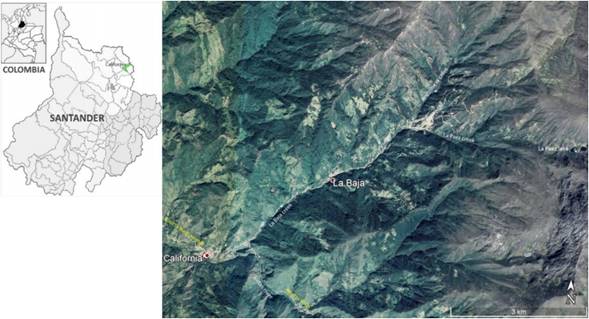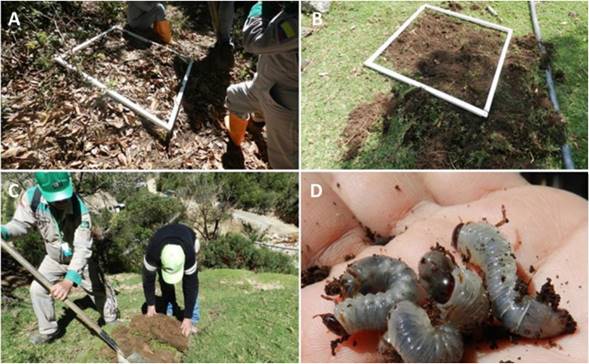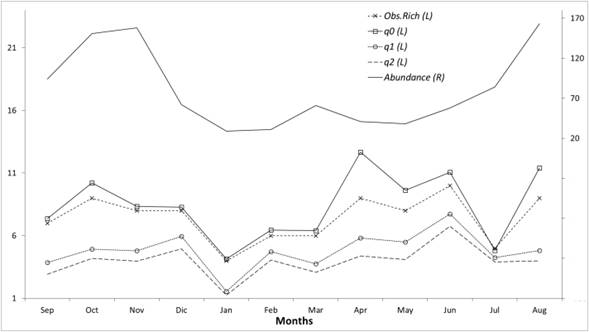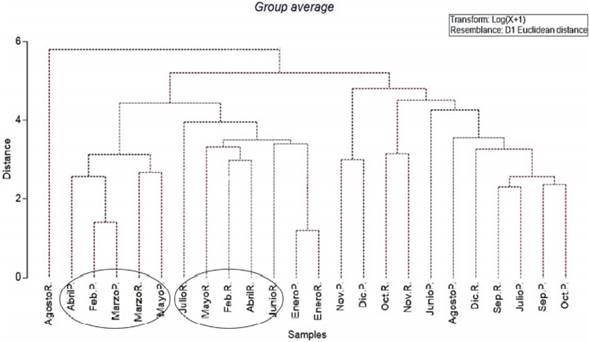Introduction
The biologic, ecologic and economic aspects of edaphic grubs of the family Melolonthidae (sensu Endrödi, 1966) (Cherman & Morón, 2014; Kohlmann & Morón, 2003) makes them a global interest group (Morón, 2001; Otavo et al., 2013; Reyes-Novelo & Morón, 2005; Smith, 2003). Many species have been object of basic y applied studies to establish the trophic interactions, impacts on the nutrients cycle, biodiversity and agricultural impacts, but also, to value anthropogenic effects on wild or intervened habitats, addressing comparative variation of its basics attributes (diversity, biomass, density) to explore ecological responses that are difficult to measure directly (Kremen, 1992; Kremen et al., 1993; Lawton et al., 1998; Márquez et al., 2013; Micó et al., 2000; Morón, 1997, 2001; Ocampo, 2008; Pardo-Locarno, 2002, 2013; Pardo-Locarno et al., 2006a, 2006b, 2011; Ulyshen & Wagner, 2013).
Groups or food guilds of edaphic macrofauna can be used to explore environmental aspects of the natural environment or a part of this (forest, biotopes, successional states, soil), so, when biological and ecological aspects are examined, ecological responses can be hypothesized, expressed these in diversity, abundance or biomass and its comparative variation (Ahrens et al., 2009; Cabrera, 2012; Cabrera et al., 2011a, 2011b; Krebs, 1985; Marín et al., 2001; Morón, 1997, 2001; Nichols et al., 2007; Pardo-Locarno, 2009; Pashanasi, 2001; Ruíz, 2007; Ruíz & Posada, 1985; Villalobos et al., 2000). The food guilds used must have attributes that facilitate their study and monitoring, such as biological and ecological records, to be relatively diverse, to have protocols of collection, manipulation and identification, and if possible, have a differential response in guild attributes and habitats (Brown, 1997; McGeoch, 1998; McGeoch et al., 2002).
In Colombia, the study of basic ecological parameters of white grubs is recent, these study has focused in richness of species, distribution and abundance, in part, on agricultural soils, especially in coffee and other crops in Andean regions (Álvarez et al., 1992; Campos & Fernández, 2002; Morón, 1997; Pardo-Locarno, 2002; Pardo-Locarno et al., 2003a, 2003b, 2003c, 2005). Other investigations have explored the diversity of white grubs in the alluvial plain of the Cauca river valley, in intervened habitats (sugarcane, pasture and forest relict), observing trends concerning the management and soil use (Pardo-Locarno, 2009, 2013). However, any studies in the agricultural environments present little information about the behavior of the Melolonthidae beetles in Colombian agroecosystems and, especially, in wild tropical environments. The present research establishes the variation of the diversity, density and biomass of white grubs of family Melolonthidae in soils intervened by mining and in oak forest soil in Surata river upper basin (Santander, Colombia).
Materials and methods
Study zone
The samplings was made in mining platforms product of gold exploration and a secondary forest with dominance of Quercus humboldtii Bonpland, 1805. It is located in the Surata river upper basin, municipality of California (Santander, Colombia) (Fig. 1) between 2,300 and 2,950 masl. The study zone corresponds to an Andean oak forest with trees in different stages of the life cycle and many elements that indicate good conservation, like Bromeliaceous, Araceous, bryophytes and epiphytic plants (Cuatrecasas, 1989; Gualdrón et al., 2012). Regarding physical conditions, the study zone presents two rain seasons (April-May and September-November), and two dry seasons (December-March and June-August); October presents the highest rainfall levels and January has lowest rainfall levels during the year. The weather is cold humid or cold very humid with the mean annual rainfall of 1,000-1,200 mm, the temperature is 12-18°C and the RH is 85-100% (Alcaldía Municipal de California en Santander, 2010; Agronet, 2013). The soils are andisols formed by volcanic ash deposited on sedimentary and igneous rocks. The relief corresponds to big ridges and escarpments with relatively thick textures, which determine a high permeability, good aeration, and capacity low of water storage (Gobernación de Santander, 2011).
Edaphic beetles sampling
Monthly, we randomly select 12 platforms with at least two years of recovery, while the 12 sites in the oak forest were selected by closeness to each platform, at not less than 50 meters. At each selected site was made a quadrant of 1 m2 x 0.3 m (Pardo-Locarno et al., 2005, 2006b; Serna-Patiño, 2004; Villegas et al., 2008), for a total 24 quadrants/month and 288 quadrants/year. The quadrant standardization was made with a wooden frame (Fig. 2) (Pardo-Locarno et al., 2006b). The specimens collected were washed with fresh water, and weighed with a digital scale (PocketScale MH 200; 200 gr, d = 0.01) to establish the biomass, which quantified in grams/m2. The density was quantified in number of individuals/m2. The collected material was preserved in bottles with a solution of alcohol-formaldehyde 10% (Pardo-Locarno et al., 2005).
Analysis of inventory quality
An analysis of sampling effort examined the degree of knowledge reached during fieldwork, considering the observed richness and thus, to predict the potencial richness of the zone. The data used for the effort-sampling units (ESU) were the sum of the monthly collections, so that, being an annual study, we considered 12 ESU. Using the EstimateS program (Colwell, 2000), data entry was randomized (1,000 iterations) to avoid bias in the estimation of potential richness. To predict the potencial richness, we used the nonparametric statistic Chao 1 (based in abundance), because it is a robust estimator of the minimum richness, and offers better results than with other estimators (Gotelli & Colwell, 2001; Walther & Moore, 2005). With CurveExpert program (Hyams, 2009), the estimates were adjusted to an asymptotic curve of Clench, and thus, to calculate the different parameters of the curve (Jiménez-Valverde & Hortal, 2003).
Seasonal diversity
Using the observed values for abundance and richness, we established for each sampling month, the values of potential richness: q0, diversity of order 1: q1 (exponential of Shannon-Wiener index: eH’) and diversity of order 2: q2 (inverse of Simpson index: 1/D) (Jost, 2006). To obtain the potential richness (q0) a procedure similar to the analysis of sampling effort was carried out, this process required the EstimateS programs (Colwell, 2000) for the randomization of data entry and use of non-parametric estimators Chao 2 (based on incidences) and CurveExpert (Hyams, 2009) for the adjustment to the asymptotic curve Clench. To obtain q1 and q2, Spade program (Chao & Shen, 2009) was used, because offers these values with their standard deviations. Correlation analysis were made with Statistica program (StatSoft Inc., 2011) to verify the degree of similarity between the different dependent variables.
Comparison between soils uses
In order to establish differences between the measured parameters (diversity, density and biomass) in the two land uses, we use the nonparametric test of Wilcoxon (Z tests) for comparison between the dependent variables using the Statistica program (StatSoft Inc., 2011). Additional analysis to establish qualitative differences between the two land uses was made with the inventory of taxa to estimate the similarity between platforms and oak forest for each month; the abundance data by species was transformed into their log (x+1), then, a matrix based on Euclidean distance was obtained. Using the program Primer 6 v6.1.6 (Primer-E Ltd., 2006), a strategy of group average and a Simprof test (1,000 iterations) was applied to construct the dendrogram.
Correlations with seasonal and biophysical factors
In order to explore the multiple relationships between the parameters measured to the edaphic grubs of the family Melolonthidae and the seasonal and biophysical variables available for the study area, generalized linear models (GLM) were used. The seasonal variable refers to sine (senm) and cosine (cosm) of day of the year, starting the year on March 21, with the spring equinox, and adjusting the 365 days to a year of 360, to use the trigonometric functions. This variable can report possible changes in abundance and richness of species that may occur in the year. Thus, when senm is positive, it is related to the period between the spring and autumn equinoxes, and when senm is negative, it is associated with the period between the autumn and spring equinoxes. When cosm is positive, it is related to the period between the winter and summer solstices, and when cosm is negative, it is associated to the period between the summer and winter solstice. The biophysical variables used were those available in the meteorological stations for the study zone. We use temperature (absolute low, absolute high, mean, mean of the low, mean of the high), rainfall (low, high, mean, accumulated, rainfall days), RH (low, high and mean), solar radiation (high and mean) and UV index (high and mean).
To establish the level of significance of each related factors, values of F were calculated for p = 0.05, 0.01 and 0.001. The goodneess of fit of the models obtained was measured by the deviance, while the change in the deviance was made through an F test and the reduction in deviance was compared with the complete model. Finally, an analysis of deviance partition was done (Legendre & Legendre, 1998) to establish the percentage of variation explained by each effect, both pure and combined, of differents seasonal and biophysical variables.
Results
We collected 970 specimens in different larval stages, belonging to 12 species. They were represented by the subfamilies Melolonthinae (56.1%), Dynastinae (20.3%), Rutelinae (22.4%) and Cetoniinae (1.2%). The most abundant species were Phyllophaga obsoleta Blanchard, 1850 (194), Isonychus sp. (188) and Platycoelia sp. (183), while the especies with lower abundance were Macrodactylus sp. (16) and Euphoria hera Burmeister, 1842 (12) (Table 1).
Table 1 Monthly abundance of larvae of family Melolonthidae collected in mining platforms and oak forest in California, Santander.
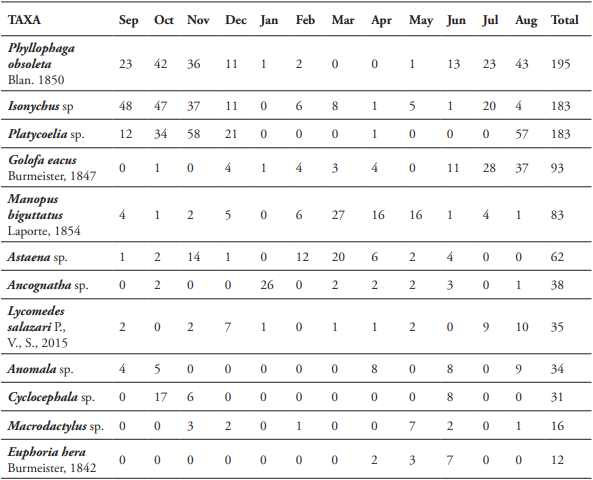
Source: Alfonso Villalobos-Moreno.
Check inventory quality
The estimated potencial richness according to the adjustment to the Clench curve reached 11.78 taxa (Fig. 3). The slope of the curve was 0.06 and the observed species proportion was 95.66%, which corresponds to an estimated sampling effort of 93.94%, these characteristics allowed to consider the quality of the inventory as appropriate.
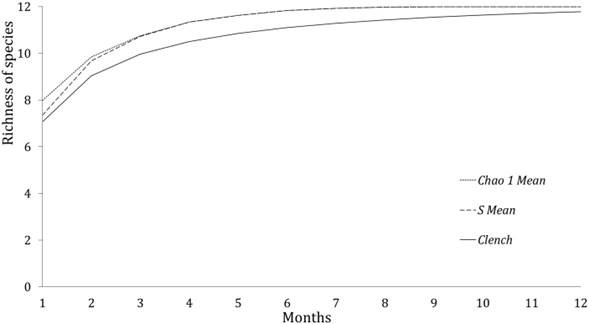
Source: Alfonso Villalobos-Moreno.
Figure 3 Analysis of inventory quality. S Means: randomied observed richness curve; Chao 1 Means: potential richness curve obtained with the nonparametric estimator Chao 1; Clench: curve adjusted to the asymptote Clench [y = 16.21·x/(1+1.29·x)]; standard error: 0.334; correlation coefficient: 0.975.
Temporal diversity
The figure 5 shows the temporal variations of the abundance, observed richness of species, and potential richness (q0), and efective richness of species (q1) and richness of dominant species (q2). The highest abundance occurs in October, November and August, while for the others variables of diversity the highest levels are in April and June. The lowest levels for all variables occurs in January, coinciding with the period of greatest drought (Fig. 4). Stadistical analysis do not show a clear relationship between abundance and the other variables.
Comparison between soils uses
Media biomass of edaphic grubs of family Melolonthidae in oak forest soil was 6.16 gr/m2 (± 10.85) and in platform was 1.38 gr/m2 (± 2.78), while media density in oak forest soil was 4.08 ind./m2 (± 5.7) and in platforms was 2.66 ind./m2 (± 4.77). The observed richness for both soil uses was similar, 12 species in the oak forest and 11 in platforms, being G. eacus Burmeister the only species that is not shared. Figure 6 shows the comparison of density and biomass in soil uses during sampling months. The analysis of similarity between localities and months give a dendrogram where the conformation of some groups is appreciated, showing some differences between the soils uses (Fig. 5). The group formed for the platforms stands out for February, April and May, and for the oak forest, for February, April, May, June and July. The analysis shows differences between platforms and oak forest for August and July. There were no differences between platforms and oak forest for the months of January, September, October, November and December (Fig. 6). However, the Simprof analysis stands out that have not seem to be significant differences in the composition of the inventories by month and location, so in principle, all the inventories would be part of the same community of species.
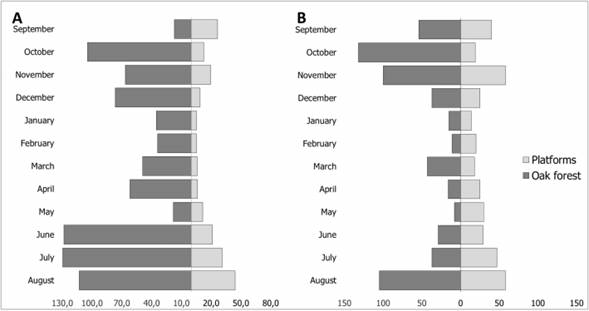
Source: Alfonso Villalobos-Moreno.
Figure 5 Comparison of density (A) and biomass (B) for sampling soil uses.
Correlations with seasonal and biophysical factors
To stablish relations between the measured variables and the environmental parameters of the study area, Generalized Lineal Models (GLM) were used. These analyses allowed affirming that exist significant correlations (negatively) between lower humidity with the abundance, the density and the biomass of platforms. There is also a relation of seasonality in platforms with abundance, density, biomass and diversities of order 1 and 2. In addition, correlations between seasonality with abundance and density in oak forest was observed (Table 2). There would be more abundance, density and biomass between summer and winter solstices than in the other half year, while there would be more diversity of order 1 and order 2 between spring and autumn equinoxes. The highest values of abundance, density and biomass would have coincided with the rainy season, that is, with the season of highest primary production. The highest values of diversity occurs at the end of the dry season and the beginning of the rainy season, probably as result of the fact that the communities are more stable during this period. Since at other seasons of the year some species have population peaks that increase their relative frequencies in the community, thus decreasing the effective and dominant species richness (q1 and q2, respectively). For all dependent variables, except observed and potential richness, seasonal and biophysical factors explain between 35% and 55% (Table 2), which prove the importance of these factors in the variation of this biodiversity in the study zone. The biophysical factors alone (pure effect) cannot explain this variation, but can do it the seasonal factors (pure effect) and its combined effect with the biophysical factors. The above corroborates the importance of the phenology of the species and their association with conditions that change throughout the annual cycle (photoperiod, primary production, etc.).
Table 2 Summary of GLM. Ab: abundance; Robs: observed richness; q0: potential richness; q1: diversity of order 1; q2: diversity of order 2; BM: biomass; D: density; P: platform; R: oak forest; Rsmax: higher solar radiation; Tmin: lower temperature; Hdmin: lower humidity; senm: senn of date; cosm: cosenn of date. Signification: !(p< 0.1), *(p< 0.05), **(p< 0.01). Sense of relationship: +/-.
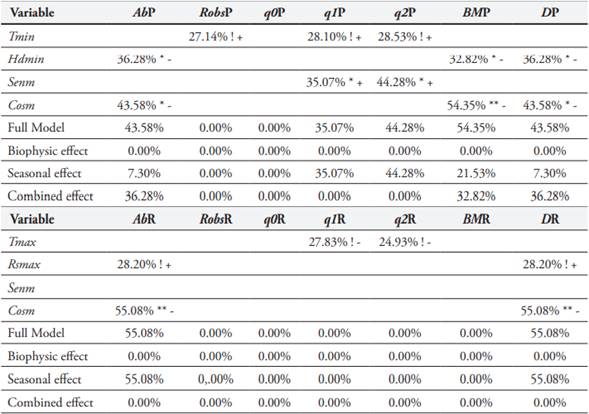
Source: Francisco Cabrero-Sañudo.
Discussion
Although the ecological importance of edaphic beetles is questionless, not much researchs in wild environmets of high Colombian montains has been done. Some investigations affirm that for decades the study of “chisa complex” in cold regions has been almost unchanged, and only five species of the genus Ancognatha Erichson, 1847, Clavipalpus Laporte, 1832, Manopus Laporte, 1840 and Heterogomphus Burmeister, 1847 have been studied (Apolinar-María, 1927; Ruiz & Pumalpa, 1990). However, recent sampling has expanded the complex to 26 species in high Andean ecosystems on departments of Cundinamarca, Boyacá and Nariño, with an accumulated record of eigth in Savanna of Bogotá, nine in Nariño highlands and 20 in Tunja higlands (Pardo-Locarno et al., 2007). Large populations of white grubs has been observed in potato, vegetable, wheat crops and pastures of Yacuanquer and Ospina (Nariño) wich 80-120 ind./m2; Ancognatha sp. and Astaena sp. were the most abundant (Peña et al., 2003). Sampling on Portachuelo and Totoró (Cauca) show variations between 0-41 larvae/m2, which include five species with saprophagus and rhizophages habits, including Astaena sp., Clavipalpus sp., Ancognatha scarabaeoides Erichson, 1847 and Macrodactylus sp. (Piedrahita & Pardo-Locarno, en prep.). Investigations in oak forest of Mexican high-mountains (Teziutlán, Puebla) found a density of 0.23 ind./m2 and a richness of nine morfoespecies, and in pine forest in Izta-Popo National Park found 1,25 ind./m2 and 3 morfoespecies (García et al., 2016), values much lower than those of the current study. The data obtained in high Andean ecosystem of Santurban show interesting variations of abundance and richness, explained by the presence of an extensive oak forest matrix, which has allowed the permanence of white grubs species and well-preserved natural populations.
Regarding relationships with enviromental factors, the analysis shows that the increase in the minimum humidity in the platforms, decrease the abundance, density and biomass of white grubs, as reported for the abundance of edaphic macrofauna by Suárez et al. (2015), Pardo-Locarno (2013) and Zebino et al. (2008), as well as for termites, worms and diplopods (Pardo-Locarno et al., 2007). Some studies carried out in coffee agroecosystems in Cauca (Colombia) showed variations in richness and abundance of chisa complex, explained, in part, by changes in humidity and temperature, that force the larvae to migrate to deeper horizons and to pupate closer to rainy seasons (Pardo-Locarno, 2002).
Conclusions and recommendations
The sampling in the two soil uses (P: platforms; R: oak forest) showed differences between biomass (R: 6.16 gr/m2; P: 1.38 gr/m2), density (R: 4.08ind./m2; P: 2.66 ind./m2), abundance (R: 575; P: 395) and richness of species (R: 12 especies; P: 11 especies), wich shows the good response of this group to soil recovery processes on mining platforms in the study zone. Only the Wilcoxon test showed significant differences for the biomass (Z = 2.903; p = 0.004) (Table 3). The minimum humidity is related with the abundance, density and biomass on platforms, as well as, some seasonal variables in the platforms and the oak forest. Sampling on platforms is recommended in a couple of years, when the vegetaction and soil structure are in a more advanced state of recovery.













